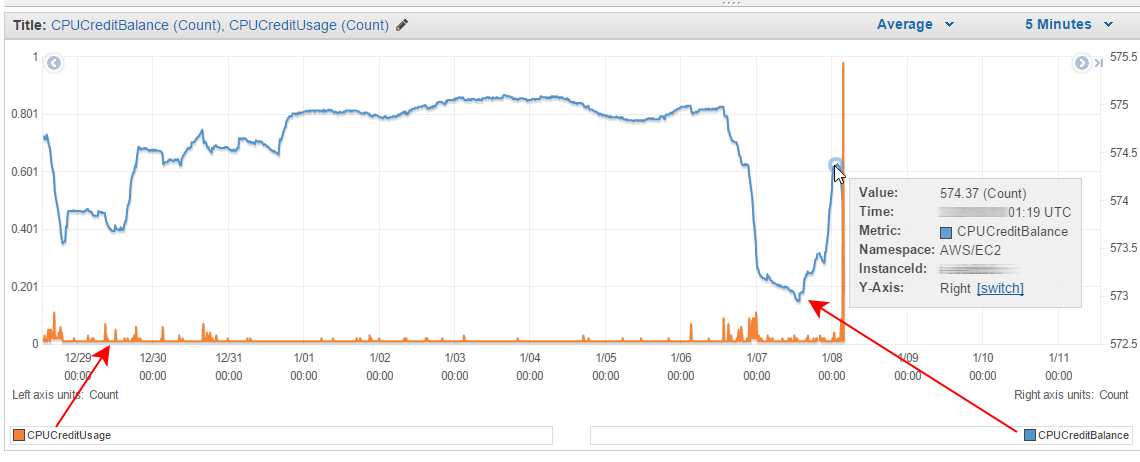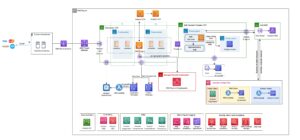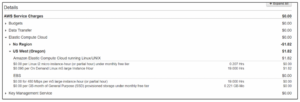AWS CPU credit usage refers to the measurement of CPU credits consumed by an Amazon EC2 instance. These credits are used for burstable performance instances and are earned during periods of low CPU utilization, which can then be used during periods of high CPU usage.
The accumulated CPU credits allow the instance to burst above its baseline performance level when needed. This feature provides flexibility and cost optimization, as users only pay for additional CPU credits if their instances consistently exceed the baseline performance level.
AWS CPU credit usage plays a crucial role in optimizing the performance and cost efficiency of Amazon EC2 instances. By earning and utilizing CPU credits, users can ensure their instances have the necessary burst capacity during periods of high CPU usage. This feature is particularly beneficial for burstable performance instances, allowing them to temporarily exceed their baseline performance level without incurring additional costs. Understanding how CPU credits are earned and consumed is essential for effectively managing the performance and cost of EC2 instances in the AWS environment. In this blog post, we will delve into the details of AWS CPU credit usage and explore its significance for users looking to optimize their AWS infrastructure.
Introduction To Aws Cpu Credits
The Basics Of Cpu Credits
AWS CPU credits are utilized by T2 and T3 instances to manage CPU performance efficiently.
T2 And T3 Instances Explained
- T2 instances are burstable and accrue CPU credits during low usage.
- T3 instances offer a baseline CPU performance with the ability to burst.

Credit: stackoverflow.com
How Cpu Credits Work
Earning Cpu Credits
AWS CPU credit usage operates on a system of earning and spending credits. When your instance is idle, it earns CPU credits, which can then be used when the instance needs more processing power.
Spending Cpu Credits
When the instance requires more processing power than its baseline performance level, it spends the earned CPU credits to burst above the baseline. If the instance runs out of CPU credits, its performance is capped at the baseline level.
Monitoring Cpu Credit Balance
AWS EC2 instances use CPU credits to enable bursting of CPU usage when required. However, if you exhaust your CPU credits, your instance’s CPU performance will be impacted. Therefore, it’s crucial to monitor your CPU credit balance to ensure optimal performance and avoid any unexpected disruptions.
Tools For Tracking Usage
AWS provides various tools to monitor your CPU credit usage and balance. You can use CloudWatch to track your CPU credit balance and usage metrics, set alarms, and receive notifications when your balance falls below a certain threshold. Additionally, you can use AWS Trusted Advisor to get recommendations for optimizing your CPU credit usage.
Understanding The Cpu Credit Metrics
To effectively monitor your CPU credit usage, it’s essential to understand the various CPU credit metrics provided by AWS. These metrics include:
| Metric | Description |
|---|---|
| CPU Credit Balance | The number of CPU credits available for bursting. |
| CPU Credit Usage | The number of CPU credits consumed by the instance. |
| CPU Credit Usage Percentage | The percentage of CPU credits used out of the total available. |
By understanding these metrics, you can effectively monitor your CPU credit balance and usage, identify any trends or anomalies, and take appropriate actions to optimize your usage.
Maximizing Cpu Credit Usage
AWS CPU Credit Usage is an essential feature that allows users to maximize their CPU performance while minimizing costs. CPU Credits are a way to measure the amount of time that a CPU can be used at 100% utilization. AWS provides users with a certain number of CPU Credits per hour, based on the instance type and size. These Credits can be used to burst CPU utilization when needed.
Best Practices For Managing Credits
Managing CPU Credits efficiently is vital to optimize your AWS resources. Here are some best practices to consider:
- Monitor your CPU Credit balance regularly to prevent running out of Credits when you need them the most.
- Use CloudWatch to set up alerts when your CPU Credit balance drops below a certain threshold.
- Choose the right instance type that meets your workload requirements and CPU Credit usage.
- Use T2 Unlimited to avoid running out of Credits when needed for your workloads.
Scaling Performance With Credits
AWS CPU Credits can be used to improve performance and scalability. Here are some tips to scale your performance using CPU Credits:
- Use Auto Scaling to automatically adjust the number of instances based on CPU utilization and Credit usage.
- Utilize Elastic Load Balancing to distribute traffic evenly across your instances and optimize performance.
- Use burstable instances to handle spikes in CPU usage and maximize your Credits.
In conclusion, AWS CPU Credits can help you maximize your CPU performance while minimizing costs. By following best practices for managing Credits and scaling performance with Credits, you can optimize your AWS resources and improve your application’s performance.
Burst Performance With Cpu Credits
When it comes to AWS (Amazon Web Services) instances, burstable performance is an essential concept to understand. It allows instances to operate beyond their baseline performance for short periods of time, providing additional processing power when needed. This burst performance is made possible through the use of CPU credits.
Burstable Performance Instances
Burstable performance instances are a type of AWS instance that allows you to enjoy a baseline level of performance with the ability to burst above that baseline when necessary. These instances accumulate CPU credits over time when their workload is below the baseline level. This allows them to build up credits that can be used for bursts of higher performance.
When your workload exceeds the baseline level, the instance consumes CPU credits to meet the additional demand. The number of credits consumed depends on the instance type and the specific workload. Once the accumulated credits are depleted, the instance will operate at the baseline level until more credits are earned.
When To Use Burst Performance
Burst performance instances are particularly useful for workloads that have varying levels of demand. If your application or workload experiences periodic spikes in activity, burst performance instances can handle the increased load without the need for constant high-performance instances.
These instances are also cost-effective for workloads that have low or intermittent CPU utilization. By using CPU credits, you can optimize your costs by only paying for the bursts of performance you actually need.
It’s important to note that burst performance instances have a limit on the maximum sustained performance they can deliver. This is known as the instance’s baseline performance. If your workload consistently exceeds the baseline, it may be more appropriate to consider a different instance type that offers higher sustained performance.
By understanding how to leverage burst performance with CPU credits, you can effectively balance performance and cost for your AWS instances, ensuring your applications and workloads have the necessary resources to handle varying levels of demand.

Credit: www.reddit.com
Cost-efficiency Of Cpu Credits
AWS CPU credit usage plays a critical role in the cost-efficiency of running instances in the cloud. Understanding how CPU credits work and optimizing their usage can significantly impact the overall cost of running applications on AWS.
Comparing Costs With Standard Instances
When comparing costs between standard instances and instances that use CPU credits, it’s essential to consider the usage patterns and performance requirements of your applications. Standard instances have a fixed cost structure, while instances using CPU credits offer flexibility based on the applications’ bursty workloads.
Budgeting For Cpu Credit Consumption
Budgeting for CPU credit consumption involves analyzing the expected workload and usage patterns of applications. By monitoring CPU credit balance and utilization, you can effectively manage costs and ensure that your applications operate within the allocated budget.
Troubleshooting Cpu Credit Issues
To address AWS CPU credit usage issues, monitor your CPU credit balance regularly. Identify any sudden drops in credit balance to troubleshoot potential performance problems efficiently. By staying proactive in managing CPU credits, you can ensure optimal performance for your AWS instances.
Common Cpu Credit Pitfalls
Understanding common pitfalls helps prevent CPU credit shortages.
Resolving Credit Shortages
Resolving shortages promptly is crucial for optimal AWS performance.
Future Of Cpu Credits In Aws
AWS CPU credit usage is crucial for managing burstable instances, impacting performance and costs. Understanding future trends in CPU credits can help optimize resource allocation and enhance overall efficiency in AWS environments. Monitoring and adjusting CPU credit usage will be key for maximizing AWS cost-effectiveness and performance in the long run.
Innovations In Cloud Computing
AWS has been at the forefront of cloud computing innovations.Predicting Changes In Cpu Credit Policies
Keeping track of CPU credit usage is crucial for performance optimization in AWS. Future of CPU Credits in AWS As cloud computing evolves, innovations drive CPU credit policies.Innovations In Cloud Computing
– AWS sets the pace for cloud advancements. – New technologies shape CPU credit allocation.Predicting Changes In Cpu Credit Policies
– Monitoring CPU credits is essential in AWS. – Adjustments in policies can impact system performance.
Credit: www.cloudinsidr.com
Frequently Asked Questions
What Is Cpu Credit Balance In Aws?
CPU credit balance in AWS refers to the amount of CPU credits available for burstable performance instances. These credits accumulate when the instance operates below its baseline. When the instance needs more CPU performance than its baseline, it consumes these credits to maintain performance.
What Happens When Cpu Credits Run Out?
When CPU credits run out, your website or application may experience a decrease in performance or even become unavailable. The CPU is responsible for processing tasks, so without enough credits, it can’t handle the workload efficiently. It’s important to monitor and manage CPU credits to ensure optimal performance.
How Do I Check My Cpu Credits On Ec2?
To check your CPU credits on EC2, go to the EC2 console and select the instance you want to check. Then, click on the “Monitoring” tab and check the “CPUCreditBalance” metric. This will show you the remaining CPU credits for your instance.
What Is Compute Credits?
Compute credits are a payment model used by cloud computing providers, where customers pay for their usage based on the number of credits used. Each credit represents a specific amount of computing resources used over a period of time, such as an hour or a day.
Compute credits allow customers to have more flexibility and cost control over their cloud computing expenses.
Conclusion
Understanding AWS CPU credit usage is crucial for optimizing performance and cost-efficiency. By monitoring and managing CPU credits, businesses can ensure smooth operation of their EC2 instances without unexpected interruptions. With a clear grasp of CPU credit mechanics, organizations can make informed decisions to enhance their AWS infrastructure.






